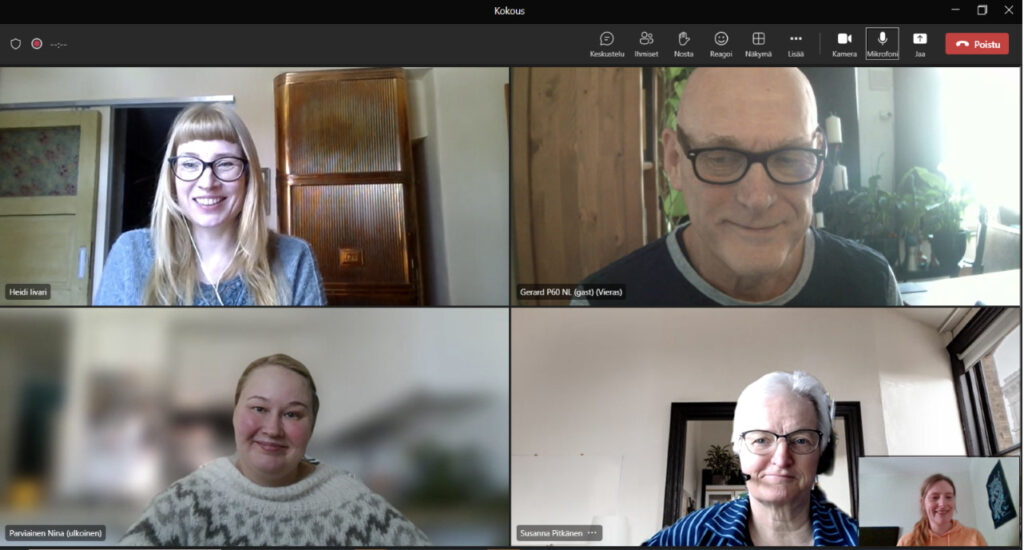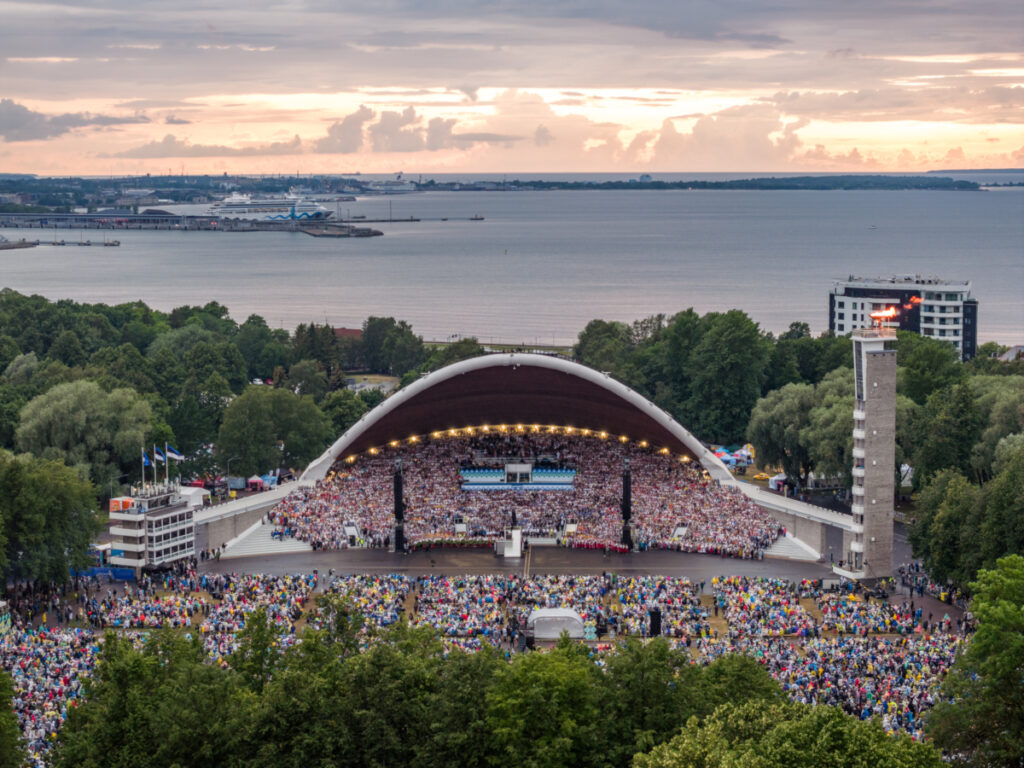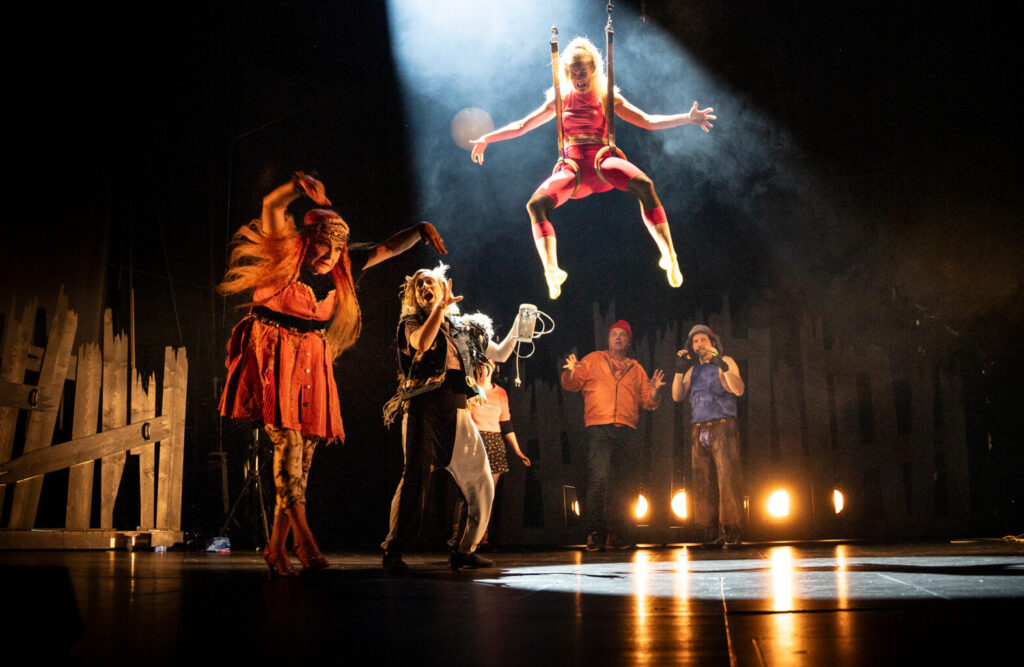The idea of this article is to compare the cultural traditions of Estonia, Finland and the Netherlands and to explore young people’s interest in them, in the past and today. What similarities and differences are there? Does the size of the nation play a role? What about location: rural vs urban?
The article is based on an online conversation held in the spring of 2023 with the participation of Ninni Parviainen, planner at Competence Centre for Municipal Youth Work Kanuuna, from Lahti, Finland , Jenni Hernelahti, lecturer at Humak, Susanna Pitkänen, senior lecturer at Humak and Diggiloo project manager, Gerard Lohuis, Director of venue P60 of Amstelveen, the Netherlands, and myself, Heidi Iivari, the writer of this article and Programme Manager of DIGGILOO at the Finnish Institute in Estonia. Riin Luks, Programme Director of Community Education and Hobby Activity and Jorma Sarv, Programme Director for Culture Management, both from Viljandi Cultural Academy, a college of the University of Tartu, contributed via e-mail.

National identity versus multi-culturalism
When I moved to Tartu in 2006, I was surprised how enthusiastically Estonians take part in nationwide events and ceremonies. The Estonian Song Festival is the biggest nationally, a tradition unifying Estonians since 1869. This choral festival also played an essential role in Estonia regaining independence after the Soviet era, with the power of “The Singing Revolution” – the documentary film of the same name is also worth watching. The Song Festival is held in Tallinn every five years alongside the Estonian Dance Festival. This year saw 31,415 young performers and 90,000 spectators out of a total population of less than 1.4 million.
Since not every hobby group is invited to perform at the festivals, a remarkable part of the free time of young Estonians is given over to choir and dancing rehearsals. “About 50,000 very devoted and motivated young Estonians are dealing monthly with the same tradition based on the same idea”, underlines Sarv. UNESCO, he adds, has declared the Song and Dance Festival tradition a masterpiece of the Oral and Intangible Heritage of Humanity.
When it comes to Finland´s cultural traditions, the first thing that comes to Parviainen´s mind is Finland´s national epos The Kalevala (1835), compiled by Elias Lönnrot. It is based on the oral epic of Karelia, a province in eastern Finland, part of which nowadays belongs to Russia. The Kalevala was rediscovered at the end of the 19th century by Finnish painters, composers and writers, as well as scientists and key figures within the national romantic movement. The Kalevala was seen as evidence of the “pure” or “original” Finnish heritage. Parviainen, who has long experience of teaching performing arts to young people and directing theatre, points out that The Kalevala is still influencing Finnish culture. “You can still see it nowadays in many interpretations especially in the theatre field.”
Since my own field is Finnish literature, I am happily surprised at how popular The Kalevala remains as a source of inspiration in the entertainment industry and, consequently, its continuing appeal amongst teenagers and young adults. Featuring in games, music, films and literature, The Kalevala also influenced J.R.R. Tolkien´s legendarium. Like “Nordic Noir” in the cinema, “Finnish Weird” is an internationally recognised subgenre of Finnish speculative fiction, combining Finnish mythology with Finns´ relationship with nature and environmental issues.
Finland, unlike Estonia, retained its independence after the Second World War, but the war has had a significant influence on Finnish society and culture, as Pitkänen points out. The war united the nation more than any other historical event in Finland. For small, sparsely populated and variable new states like Estonia and Finland, language, literature, theatre and music have been and continue to be important tools for maintaining and strengthening national identity.

But what about in the Netherlands?
“Totally different”, says Lohuis. “The Netherlands has been a very multi-ethnic country since the 17th century, when the first refugees came to the Netherlands. And we have the history of being a coloniser for 400 years. Nowadays there are 18 million people living in a very small area. So, the people are very packed, but with very different backgrounds and cultures.” Lohuis mentions the annual King´s Day on 27th April as an example of a vital cultural tradition. “It is a big carnival and there are flea markets throughout the whole country, and young people take part in it too by selling their things and wearing orange clothes and flags”. A similar but much newer tradition is the 1st of May in Finland and Estonia, which is celebrated less and less as a Labour Day – especially in Estonia, where soviet traditions carry negative associations – but as the students´ spring fest. Another nationally unifying tradition in Estonia and Finland is Midsummer.
Though there are few immigrants in Estonia and Finland compared to the Netherlands, it is worth of adding that the indigenous people such as Samis in Finland and Setos in Estonia are part of the countries´ cultural traditions and their impact on the national identity is remarkable not only historically but also today as Parviainen, Pitkänen and Sarv point out.

Rich patrons of the arts versus governmental support
Estonia, Finland and the Netherlands are all situated next to the sea, but unlike in Finland and in Estonia, the waterway has played a key role in the Netherlands becoming a rich and liberal country. Water is also a very important element in Dutch leisure and cultural activities. Lohuis mentions a five-day ice-skating event in which people can skate through eight cities, a tradition which is increasingly under threat due to climate change.
“Since half of the country is under or next to the water, the ships and therefore trade and earning money have always had a very big footprint in the Dutch history and traditions”, explains Lohuis. But practical business-oriented thinking has also ensured the Netherlands is a forerunner when it comes to the western values. “The country is very liberal because of the trade, the democracy started to develop very early as well as people´s rights, the equality and freedom of religion and opinion.”
According to Lohuis, this tradition still influences how culture is financed in the Netherlands. “Before the Second World War, culture was funded only by the private money, and you can see this also nowadays: you can´t have more than 50 % public support for your projects. Financial independence is very important in the Netherlands”, says Lohuis.
Again, this is not the case in Estonia and Finland. “Youth culture in Estonia is financed by the local government´s budget according to the priorities of the Youth Sector Development Plan for 2021-2035.” says Luks. “Activities pursuing wider national impact are financed from the state budget, like Estonian and Ukrainian youngsters’ cultural camps. Some youth associations also get regular annual grants from the state budget.”
The power of local activism
The financing and organising of cultural youth work is more centralised in Estonia and Finland and is supported at the governmental level. In the Netherlands, in contrast, local authorities have greater independence. NGOs, nevertheless, play an important role in all three countries. As Parviainen reminds us, local NGOs and other grassroot organisations do essential work today, but they were also the initiators and forerunners of professional youth work and cultural institutions such as theatre in 19th century Finland. Finland has a remarkable tradition of over 500 local amateur theatre groups which unite whole villages and all age groups and between them organise over 450 summer performances. Intergenerational music and dance ensembles are also popular in local communities.
Luks notes that, in Estonia, some tasks of practical implementation, like hobby education and youth work umbrella organisations, are delegated to youth work NGOs. Lohuis points out that youth cultural venue P60 in Amstelveen, for instance, would not exist without ten years of grassroots work and access, and the initiative of young people themselves. Both governmental support and strategy and grassroot level activism are needed for effective youth work, adds Pitkänen.
The role of the grassroot movement has been and is still especially important in the countryside, where NGOs are enabling youth hobbies and clubs. Estonia and Finland can still be proud of their very wide network of libraries, but that is no longer the case in the Netherlands. “Because of the financial crisis in 2007, lots of small and local libraries disappeared, especially in the villages and therefore many cultural activities in the countryside”, says Lohuis.

Challenges and empowering
There are differences in the accessibility of cultural activities in urban and rural environments. “It is more and more difficult to offer high quality free time activities to the smaller amount of people living in the countryside”, says Sarv in the case of Estonia. Luks adds that one of the challenges in Estonia, is the lack of professional youth workers.
Pitkänen takes up the issue of the accessibility of culture in small cities and in the countryside. The solution has been to establish arts education institutes and children’s cultural centres throughout the country and to allocate resources and support. Local cultural youth work offered by volunteers and youth workers is extremely important.
Lohuis points out that although the cultural policy is based on the idea of equality, and culture and education are considered to belong to everyone in the Netherlands, low-income citizens tend not to take part in cultural activities. “This is the case especially in ethnic communities like the Turkish or Moroccan communities, they are more focused on surviving, earning money, so even if they have access to the cultural activities, they just don´t have time for it or they don´t even know about those possibilities”.
Parviainen, who has lot of experience of youth theatres such as Timotei Teatteri and Legioonateatteri in Tampere, says that performing arts – and community theatre, in particular – is an effective way to bring together young people with different backgrounds, facing a range of social problems. “Theatre is a good tool to help you take life into your own hands.”
Hernelahti agrees with Parviainen but observes that empowering people through performing arts is quite a new phenomenon and therefore not yet entirely organised: “Many organisations and professionals of social theatre focused on children and youngsters have emerged in the last ten years in Finland.”
“Theatre is indeed a good tool for diversity and inclusion in the Netherlands, too”, agrees Lohuis. He has encountered this in his own organisation, P60, where young offenders can undertake community service instead of going to prison. “The system works very well, and the youngsters often start to make theatre, and play or record music. Sometimes they want to continue working as a volunteer in P60 after serving time”, he adds.
There are many theatre and circus schools for children and young people in Estonia and Finland, but youth circus is not popular in the Netherlands, according to Lohuis. Similarly, Estonia and Finland have seen a revival of interest in traditional handicraft such as knitting with national patterns and folklore music and dance, unlike in the Netherlands. Estonian and Finnish youngsters also see board games and escape rooms as a nice way to gather and meet other young people – again, unlike in the Netherlands. When talking about global trends, gaming is popular in all three countries. Though we can see threats in it, such as gaming addiction, it can be also empowering, especially, if the gamer can play an active role in creating the virtual reality.
Same aims and values
In conclusion, we can say that despite differing cultural traditions and historical backgrounds in Estonia, Finland and the Netherlands, we share the same aims and values, which impact cultural youth work. All three countries are based on the European democracy; equality and the inclusion of minorities – immigrants or indigenous peoples – are part not only of our cultural traditions but also of our contemporary culture. One of the most important aims is to encourage and enable young peoples´ interests and their access to cultural activities and hobbies regardless of their background. While there are countless trends, subcultures and interests, which vary to country to country and change quickly, young Finns and Estonians seem to have a stronger connection with cultural traditions than their Dutch peers.

Author Heidi Iivari is DIGGILOO project manager at the Finnish Institute in Estonia.








